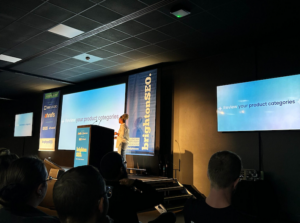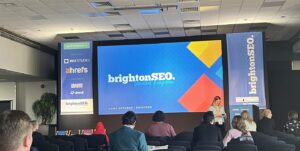
Faceted navigation to going headless

In October 2024, I was lucky to travel down south to BrightonSEO. Known globally as a hub for learning, the conference involves talks and workshops while encouraging networking within the impressive exhibition area. Attending an industry-leading event only three months into my digital marketing career equipped me with tons of insight and inspiration.
Matt, from the social team, Hollie, from the brand and I attended three talks: first, about social media, then e-commerce optimisation, and finally, content optimisation. Each talk provided extensive insight into its topic. However, I left the e-commerce optimisation talk particularly stirred to share the findings.
E-commerce optimisation
To kick off the event, Naomi Francis-Parker, SEO manager at Charlotte Tilbury, presented ‘From clicks to conversions: unlocking the power of faceted navigation for e-commerce success’. Naomi began the talk focusing on the absolute necessity of site speed then shifted the focus onto faceted navigation.

It is a UX feature which helps users filter and sort listings based on a variety of attributes. Typically, large e-commerce sites that have extensive product listings benefit from the use of faceted navigation as it speeds up the user journey. Having a clear, well-thought-out navigation system is such a valuable asset of an e-commerce site as it allows the user to find exactly what they are looking for and then hopefully convert.
Naomi discussed the absolute value in optimising the use of faceted navigation, placing specific emphasis on the importance of putting your customer first. Supporting this point with the statistic “48% of customers spend more when their experience is personalised”. To begin implementing faceted navigation, it is imperative to find where the demand is to successfully select categories. This can be done through tracking or Naomi suggested going the extra step and speaking to your sales teams.
They are the people who are talking to customers every day, and know which products gain the most attention. Naomi then drew upon ensuring the search result is relevant to the search term, saving the users time with accurate faceted navigation is key to improved UX. Carrying out thorough keyword research helps in defining which subcategories to be included based on demand. To support the updated faceted navigation, Naomi discussed the value of creating supporting blog content to categories in facilitating backlinks.
The key takeaway from Naomi’s talk for me was utilising the sales team when designing faceted navigation. It is so easy to be tunnel-visioned when working in digital marketing, only using tracking data. However, so much value can come from the sales team, they know the products we are trying to sell inside out and will be able to provide invaluable knowledge into consumer purchasing behaviour.
Web servers, checkout processes and designing for conversions
We then heard from Ahmed Bhula who presented his talk on, ‘developing the perfect optimised WooCommerce site for maximum conversions’.
Ahmed began with a focus on the web server of an e-commerce brand’s WooCommerce site, citing that ‘a 1-second delay in page speed load time results in a 7% decrease in conversions’. Ensuring an e-commerce web server performs well is key for overall performance, so it is essential to keep track of activity. One free tool Ahmed suggested was UptimeRobot, an uptime monitoring service that checks your site every 5 minutes for downtime. With ‘53% of mobile users abandoning a site that takes longer than 3 seconds to load’, using tools such as UptimeRobot and Page Speed Insights are invaluable for improving e-commerce performance.
Ahmed then shared the statistic, ‘38% of consumers look at a page’s navigational links and layout when looking at a site for the first time’, reinforcing the value of Naomi’s talk. Using usability tools, such as Hotjar, provides insights into the UX of your site. Ultimately, Ahmed concludes his talk with a focus on design for conversions. Drawing on the value of trust signals on-site and how important optimising the checkout process is. Ahmed also recommended Steve Krug’s book, Don’t Make Me Think, which has definitely been added to my reading list.
Ahmed’s explanation of the importance of a high-performing web server particularly resonated with me. As a consumer, I realise how quickly I abandon slow-loading sites, making the statistics Ahmed shared extremely insightful. Being a PPC assistant, I rely on users clicking my ads, but if the web server is slow, conversions are unlikely. A fast server isn’t just technical, it directly impacts user experience and ad performance.

A brief introduction to headlessness
The final of the three talks was by Peter Richman, in which he answered the question ‘Is headless Shopify the way forward for eCommerce businesses?’.
The previous two talks were familiar to me as they linked to responsibilities I had during my placement year whereas headlessness was a whole new term. Going headless refers to the front end of the Shopify store being decoupled from the back end. For example, changes to products and inventory have no impact on the front-end designs which can then be aimed at user experience and performance needs.
Peter highlighted the benefits of being headless as better URL management, improved content on collection pages, improved page speed and making the site internationally simpler. A benefit also linked back to faceted navigation, is the ease of duplicate content based on the URL variation with headlessness. Peter informed the crowd of the absolute value of taking a Shopify site headless and inspired me to learn more about the technical side.
Although not completely confident about the technicalities of going headless, my main takeaway from Peter’s talk is the importance of customisation. After it being mentioned in the previous two talks, I felt Peter portrayed the scalability of implementing customisation as a benefit of going headless which was extremely interesting.
Want to learn more about going headless? Read a recent blog here, explaining how to incorporate SEO into headless CMS.
Some final thoughts
After listening to Naomi, Ahmed, and Peter discuss e-commerce optimisation, I left feeling truly inspired. Each talk was clear and captivating, allowing me to reflect on how I could apply their insights to my PPC strategies for e-commerce clients. Their advice offered practical ways to improve performance and optimise campaigns effectively and I’m excited to integrate their ideas into my work to drive better results. Want to learn more about optimising your e-commerce strategy? Contact our team of paid media experts.


